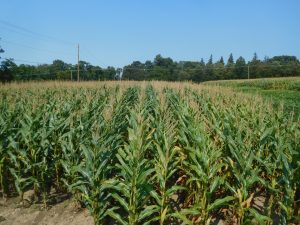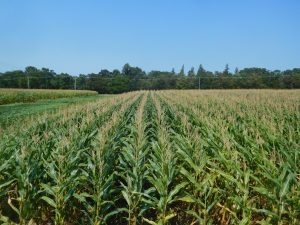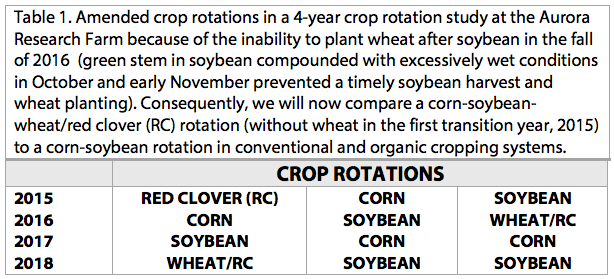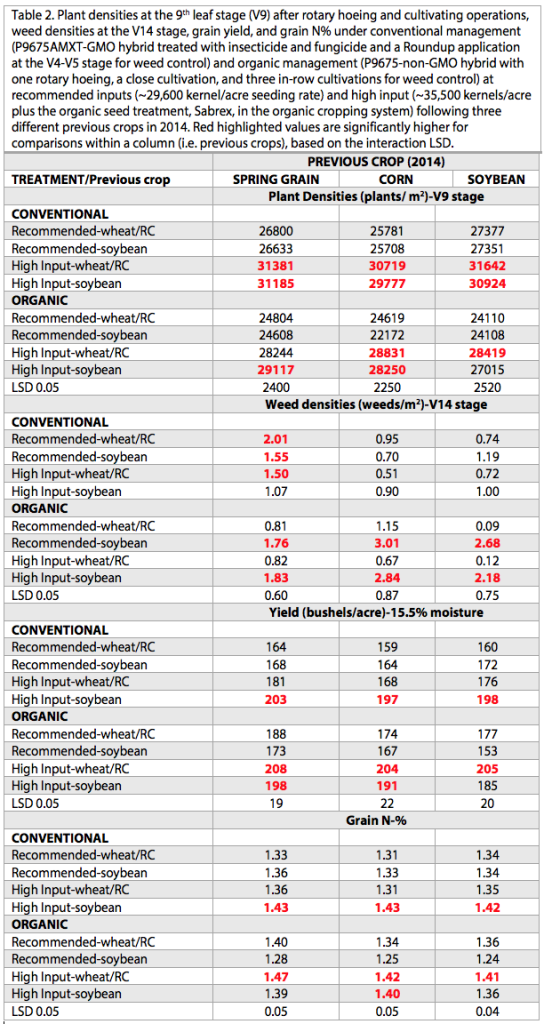Bill Cox, Eric Sandsted, Phil Atkins, and Jerry Cherney

We initiated a 4-year study at the Aurora Research Farm in 2015 to compare different sequences of the corn, soybean, and wheat/red clover rotation in conventional and organic cropping systems under recommended and high input management during the 36-month transition period from conventional to an organic cropping system. We provided a detailed discussion of the various treatments and objectives of the study in a previous news article at the onset of the study (https://blogs.cornell.edu/whatscroppingup/2015/07/23/emergence-early-v4-stage-and-final-plant-populations-v10-psnt-values-v4-and-weed-densities-v12-in-corn-under-conventional-and-organic-cropping-systems/). Unfortunately, we were unable to plant wheat after soybean in the fall of 2016 because green stem in soybean, compounded with very wet conditions in October and early November, delayed soybean harvest until November 9, too late for wheat planting. Consequently, corn followed soybean as well as wheat/red cover in 2017 so we are now comparing different sequences of the corn-soybean-wheat/red clover rotation with a corn-soybean rotation (Table 1). This article will focus on corn yields while also providing supporting plant density, weed density, and grain N data.

The red clover green manure crop (~2.5 dry matter tons/acre and ~3.85% N in the organic plots but only 1.25 tons/acre and ~3.0% N in conventional plots), which was inter-seeded into the 2016 wheat crop, was mowed on May 16. Organic corn in the high input treatment following wheat/red clover received a broadcast application before plowing of ~50 lbs. N/acre of Kreher’s composted manure (5-4-3) but none in the recommended input treatment; and ~100 lbs. N/acre in the recommended input and ~140 lbs. N/acre in the high input treatment following soybean.
The fields were plowed on May 17, then cultimulched on the morning of May 18, the day of planting. We planted a treated (insecticide/fungicide seed treatment) GMO corn hybrid, P96AMXT, in the conventional system; and its isoline, the untreated non-GMO, P9675, in the organic cropping system at two seeding rates, ~29,600 kernels/acre (recommended input treatment) and 35,500 kernels/acre (high input). The high input organic treatment also received the organic seed treatment (in-hopper), Sabrex.
Conventional corn received ~250 lbs. /acre of 10-20-20 as starter fertilizer, whereas organic corn received about ~315 lbs. /acre of Kreher’s composted manure through the planter. Conventional corn was side-dressed on June 15 (V3-4 stage) with ~50 lbs. N /acre in the recommended input and ~90 lbs. N /acre in the high input treatment following wheat/red clover; and ~90 lbs. N/acre in the recommended input and ~140 lbs. N/acre in the high input treatment following soybean.
We applied Roundup (Helosate Plus Advanced) for weed control in conventional corn (V4-V5 stages) under both recommended and high input treatments. We used the rotary hoe to control weeds in the row in recommended and high input organic corn at the V1-2 stage (June 2). We then cultivated close to the corn row in both recommended and high input organic treatments at the V3 stage (June 12) with repeated cultivations between the rows at the V4-V5 stage (June 22), the V5-V6 stage (June 28), and the V7-8 stage (July 5).
We estimated corn densities at the V1-2 stage by counting all the plants along the 100 foot plot in the two middle harvest rows, just hours before the rotary hoeing operation. We then estimated corn densities again at the V3 stage, 10 days after rotary hoeing but before the first cultivation; and again at the V9 stage after completion of all in-row cultivations. We will provide just the V9 data in this article because we already provided corn density data at all three growth stages in a previous article (https://blogs.cornell.edu/whatscroppingup/2017/07/26/close-cultivation-followed-by-three-in-row-cultivations-reduce-organic-corn-plant-densities-by-another-3-5-or-1000-plantsacre/). We estimated weed densities (greater than ~2 inches in size) at the V14 stage (July 20) by counting all the weeds along the 100 foot plot between the two harvest rows. We harvested corn with an Almaco Plot Combine on October 19, when grain moistures were in the 17-19% range. We collected ~1000 gram samples from each plot to determine grain moisture, test weight, and grain N.
Organic corn had 9% lower plant densities compared with conventional corn at the V9 stage (Table 2). As mentioned in previous articles, plant densities were similar between organic and conventional corn 12 days after planting (https://blogs.cornell.edu/whatscroppingup/2017/06/05/organic-and-conventional-corn-have-similar-emergence-and-early-plant-densities-in-2017/). The rotary hoeing operation, however, reduced plant densities in organic corn by 5.5%, and the repeated cultivations, including the close cultivation at the V3 stage, reduced plant populations an additional 3.5% (https://blogs.cornell.edu/whatscroppingup/2017/07/06/rotary-hoe-operation-at-the-v1-2-stage-decreases-organic-corn-plant-densities-by-5-5-but-has-limited-effect-on-organic-soybean-plant-densities/). Consequently, the recommended treatment in organic corn had final plant densities of only 22,000-24,000 plants/acre, too low for optimum yields on most soils in New York.
The repeated cultivations in organic corn provided satisfactory to excellent weed control, depending upon the previous crop in 2016 (Table 2). As mentioned in a previous article (https://blogs.cornell.edu/whatscroppingup/2017/08/10/wheatred-clover-provides-n-and-may-help-with-weed-control-in-the-organic-corn-soybean-wheatred-clover-rotation/), weed densities in organic corn following the 2016 wheat/red clover crops were similar or lower compared with conventional corn. Weed densities in organic corn when following soybean in the rotation, however, were consistently greater than weed densities in conventional corn or organic corn following wheat/red clover. As mentioned in the previous article, it is not completely clear why weed densities were so much lower in organic corn following wheat/red clover compared with following soybean (separated only by a 10 foot border row) across all three fields with different 2014 previous crops.
Corn yield showed a cropping system x input treatment interaction (Table 2). In a true shocker, organic compared with conventional corn with high inputs following wheat/red clover yielded a stunning 31 bushels/acre greater (206 bushels/acre vs. 175 bushels/acre average yields, respectively, Table 2). ). As mentioned in the weed control article, organic corn with high inputs following wheat/red clover was poised to yield as well as conventional corn in 2017 because final stands averaged ~28,500 plants/acre, pre-sidedress nitrogen (PSNT) values averaged ~30 ppm, and weed densities averaged only ~0.55 weeds/m2. We did not expect it to yield 18% higher, however.
What happened? We mentioned that red clover, frost-seeded into organic winter wheat in early March of 2016, averaged 2.25 tons/acre of dry matter with 3.85% N compared with only 1.25 dry matter tons/acre with a 3.0% N concentration in conventional wheat. For some unknown reason, the ammonium nitrate applied to conventional wheat in April of 2016 resulted in poor red clover growth. Consequently, we side-dressed 50 lbs. N/acre to the recommended conventional treatment and 90 lbs. N/acre to the high input conventional corn treatment following wheat/red clover (instead of the intended 0 and 50 lbs. N/acre, respectively). Nevertheless, conventional corn following wheat/red clover in the recommended treatment (50 lbs. N/acre) yielded an average 18 bushels/acre lower than the recommended organic corn treatment, which received no additional N and relied totally on plowed in red clover for its N supply. Apparently, the red clover crop provided essentially zero N to conventional corn as indicated by the 14 bushel /acre increase in the high input treatment, which received 50 lbs./N/acre side-dressed. Conventional corn following soybean, which received 90 and 140 lbs. N/acre sided-dress N, compared with organic corn following soybean, which received comparable organic N rates, yielded similarly (numerically higher) in both the high and recommended input treatments (Table 2).
Both organic corn and conventional corn responded to high inputs in 2017. When averaged across the three previous crops and two rotations, conventional corn showed an average 23 bushel/acre yield increase with high inputs; whereas organic corn showed a 27 bushel/acre increase. The experimental site received about 10 inches of precipitation from side-dressing (June 15) until the end of July, which probably resulted in considerable leaching of side dress liquid N, but much less of the slowly released organic N from plowed-down red clover. We believe that lack of available soil N in the recommended input treatment probably resulted in the yield response to high inputs in conventional corn. In organic corn, however, the lack of available soil N, especially when following soybean, as well as final plant densities of only 22,000-24,000 plants/acre probably resulted in the yield response to high inputs.
Grain N% showed a cropping system x input treatment interaction (Table 2). Grain N% showed a consistent 0.06 to 0.12% grain %N increase in the high vs. recommended input treatments in both organic and conventional systems (even with the significant yield increases), except in the conventional system when following red clover (average 1.33 and 1.34% N, respectively). Critical grain N concentrations vary greatly according to growing conditions and are difficult to detect. Some studies have suggested that a grain N concentration of 1.31% N separates sufficiency from deficiency. Only the high input conventional treatment following soybean and the high input organic treatment following red clover, the highest yielding treatments, were clearly above the 1.31% grain N threshold, consistently in the 1.41 to 1.43% N range.
Correlation analyses indicated highly significant correlations between grain yield and grain N% (r=0.68, n=88) as well as grain yield and plant densities at the V9 stage (r=0.46, Table 3). Grain yield and weed densities at the V14 stage had a weak negative correlation (r=0.20). Apparently available soil N and plant densities were the major drivers of corn yields in 2017, when excessively wet soil conditions persisted through the end of July.
Organic corn is eligible for the organic premium this year so with similar or greater yields, organic compared with conventional corn would be more profitable in 2017. Costs, however, would be greater for organic corn, especially with high inputs, because of the 10x more expensive N fertilizer, associated with the cost of Kreher’s composted manure (many organic growers, however, use a far cheaper source of organic N than composted manure). Likewise, weed control costs in organic corn would be higher because of the five trips across the field for rotary hoeing and cultivation. In addition, seed costs for organic corn, although lower than conventional seed costs, would increase because of the apparent need for higher seeding rates to account for the 5,000 plant/acre plant loss incurred during rotary hoeing and cultivation operations. (We will increase our recommended seeding rate recommendation for organic corn to 35,000 kernels/acre in the 2019 Cornell Guide for Field Crops). Nevertheless, the organic premium will offset the additional costs for 2017 organic corn production.




